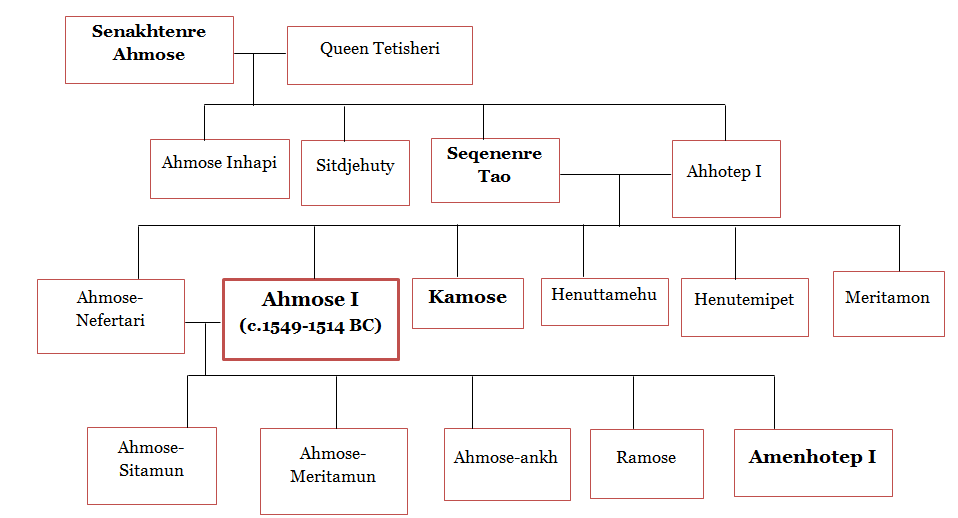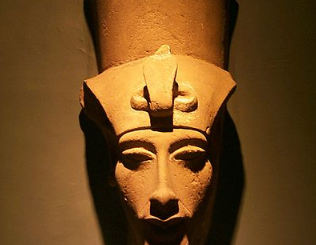Ahmose I: History, Accomplishments and Facts

Ahmose I – Biography and achievements
Facts about Ahmose I, founder of the 18th Dynasty of ancient Egypt
Born: c. 1549 BC
Died: c. 1514 BC
Father: Pharaoh Seqenenre Tao
Mother: Ahhotep I
Sibling: Pharaoh Kamose
Consort: Ahmose-Nefertari (God’s Wife of Amun), Ahmose-Sitkamose, Ahmose-Henuttamehu, Thenthapi
Chief Royal Wife: Ahmose-Nefertari
Children: Ahmose-Sitamun, Ahmose-Meritamun, Ahmose-ankh, Ramose, Amenhotep I, and Mutnofret
Reign: c. 1539- 1514 BC
Predecessor: Kamose
Successor: Amenhotep I
Dynasty: 18th dynasty
Most known for: the expulsion of the Hyksos; founder of the 18th dynasty
Burial place: Abydos
Mummy: found in Deir el-Bahri
Epithets: “The Lord of Strength is Ra”
Ahmose I was an ancient Egyptian king who reigned from around 1540 to 1514 BC. He is most famous for being the founder of the 18th dynasty of ancient Egypt. This Egyptian king is credited with the expulsion of the Hyksos – a ruling family of Asiatic origins – from the land of Egypt.
Other feats of Ahmose I include his successful military campaigns in places like Palestine and northern Nubia. He was an extremely influential king of Egypt whose reign ushered ancient Egypt into a new age (i.e. the New Kingdom era), an age of regional dominance and prosperity never seen before.
Meaning of Ahmose
In ancient Egypt, Ahmose’s name was related to the word “moon” (lah). One of his epithets reads as “the Moon is born”.
Family
Ahmose I hailed from a very powerful ruling family in the Upper Egyptian city of Thebes. This future pharaoh was born to Sequenenre Tao and Ahhotep I. Typical of ancient Egyptian royal family, his father had numerous wives and children. It has been said that his parents were siblings. Incest marriage was another common phenomenon among ancient Egyptian royal family.
He had an older brother called Kamose and many sisters and brothers. Ahmose I married one of his sisters called Ahmose-Nefertari. When Ahmose I became pharaoh, Ahmose-Nefertari served as the Chief Royal Wife. Together with Nefertari, Ahmose had many children, including Meritamun, Sitamun, Ahmose-ankh, Amenhotep I, and Ramose.
After the death of his first heir Ahmose-ankh, his son Amenhotep became the crown prince.
Family tree

Family tree of Pharaoh Ahmose I of the 18th dynasty
Reign
Ahmose I’s father, Theban ruler Sequenenre, died when Ahmose was around three years old. The crown then passed on to Ahmose’s older brother Kamose, who ruled for about seven years.
Examination of the mummy of Ahmose I revealed that the he died around his mid-30s. If we are to go by the 25-year reign Egyptian historian Manetho (c. 300 BC) gives to Ahmose I, then it means that Ahmose I inherited the throne from his brother Kamose at the age of 10. His mother Ahhotep served as regent during his minority years. Kind courtesy of his mother’s consolidation of power, Ahmose I had the full support of Thebes when assumed full control of Thebes. The young king would then set out to drive out the Hyksos from all of Egypt, starting in their capital city, Avaris.
Theban rulers versus the Hyksos
Perhaps fed up with the Hyksos rulers, a revolt was orchestrated by Theban king Seqenenre Tao, Ahmose I’s father. The goal was to oust what Theban rulers and generals described as a foreign dynasty. In the ensuing years, Seqenenre Tao waged a brutal war against the Hyksos in Lower Egypt. Several raids were mounted on Avaris, the Hyksos capital.
Unfortunately for the Theban cause, King Seqenenre Tao, the 8th king of the 17th dynasty, died in battle. His oldest son Kamose succeeded him. Kamose continued from where his father left off and fought against the Hyksos king Apepi (also known as Apophis). It’s been estimated that Kamose reigned for about three years. However, he made so many gains against the Hyksos in Lower Egypt that his successor, Ahmose I, would go on to completely expel the Hyksos from the land of Egypt.
Notable Achievements of Ahmose I

Achievements of Pharaoh Ahmose I | Image: Ancient Egyptian King Ahmose I slaying a probable Hyksos soldier or general.
In addition to being the founder of the 18th dynasty and the king who reunified Egypt, Ahmose I attained a number of things for his people. The following are 10 most notable achievements chalked by Pharaoh Ahmose I:
- Ahmose I opened up the rich gold mines in the south of Egypt
- He expanded Egyptian territory and influence into Nubia
- He properly secured the borders of Egypt.
- King Ahmose I set up a strong administrative body in every region of the country. He made sure that the overseers he appointed reported directly to him or his vizier.
- Pharaoh Ahmose I was generous to his top commanders and local leaders that fought beside him. He is said to have properly rewarded any general, statesman and royal family member who was loyal to him. Besides, a good portion of the spoils and captives of his military campaign went to the military class.
- Ahmose I opened up the copper mines in Sinai.
- He increased trading opportunities between his kingdom and cities in Syria.
- It was during his reign that advances were made in the art of glass making. We know of this because of the discovery of one of the earliest glass beads that had the names of Ahmose I and his successor Amenhotep I.
- He was responsible for building magnificent temples and buildings. Most notable of those projects were the chapels he built at Abydos.
- Under his reign, Egypt was re-united again. The unification coupled with his system of governance allowed Egypt to attain a kind of prosperity that had never been seen before in the past.
Ahmose’s Pyramid

Ahmose biography and achievements |Image: The ruins of the Pyramid of Ahmose I, King of ancient Egypt, 18th Dynasty
Subsequent Egyptian kings of the New Kingdom were not so keen to build close to Ahmose I’s pyramid because the area was susceptible to flooding. The cliffs in the region were also a huge turnoff for New Kingdom pharaohs. Ahmose’s pyramid leaned more in favor of the sun god Re (Ra).
With the rise in prominence and worship of Amun (also known as the “Hidden One”), New Kingdom pharaohs did not have the burning need to have their mortuary temples and tombs all in the same structure. Being the physical manifestation of Amun (i.e. “The Hidden One”), New Kingdom pharaohs opted to hide their mummies from grave robbers. This explains why many of them were buried in the Valley of the Kings.
More facts about the Pyramid of Ahmose I
- Discovered in 1899, and then properly excavated in 1993, the ruins of the Pyramid of Ahmose I in Abydos measure about 10 m tall today.
- In the cenotaph pyramid of his grandmother Tetisheri, Pharaoh Ahmose I can be seen making offerings to her.
- Based on the evidence so far, the Pyramid of Ahmose I is considered the last pyramid that forms part of a mortuary complex.
Who succeeded Ahmose I?

Ahmose I was succeeded by his son Amenhotep I | Image: Osiride statue of Amenhotep I, currently housed in the British Museum.
King Ahmose I is said to have died in his 25th year on the throne. After his death, crown prince and his oldest son Amenhotep I succeeded him to the throne. In his later years, it is possible that he co-ruled with his heir and oldest son Amenhotep I.
Mummy

The mummified head of Ahmose I at the Luxor Museum.
The mummy of pharaoh Ahmose I was unearthed near the Deir el-Bahri Cache in 1881. They were found in the hills near Queen Hatshepsut’s mortuary temple.
While examining the mummy, French Egyptologist Gaston Maspero carefully unwrapped the mummy which was inside a coffin. On the coffin was the name of Ahmose I in hieroglyphs.
The examinations revealed that Ahmose’s mummy had been relocated from his original burial place. It is also possible that he was re-wrapped while the moving was taking place. Scholars believe that the relocation of his mummy took place around the 21st dynasty. This is because the name of 21st dynasty king Pinedjem II can be seen on Ahmose’s mummy’s wrappings.
Forensic sweep of the place in which the mummy was discovered shows that it’s likely the place was pillaged by grave robbers. There is an indent on his nose, possibly the result of it been smashed. His neck appeared to be ripped off from his body. All of those are telltale signs that the site was robbed sometime in the past.
The discovery also revealed that other pharaohs from the 18th and 19th dynasties had their mummies placed in the area. Those pharaohs were Amenhotep I, Thutmose I, Thutmose II, Thutmose III, Ramesses I, Seti I, and many others.
How tall was Ahmose I?
Examinations from the mummy showed that his body measured at around 1.63 m in height. Ahmose was therefore of a medium height, possibly around 1.67 m. There is a strong resemblance between his facial features and Theban king Seqenenre Tao, giving more credence to the point that Ahmose’s father or grandfather was indeed Seqenenre.
How old was Ahmose I when he died?
Again, the revelations from examination of the mummy put his age at the time of death at around the mid-30s.
More Pharaoh Ahmose I facts

Ahmose I – military campaigns | Image (L-R): Dagger of Ahmose I, Luxor Museum; Ceremonial Axe in the name of Ahmose I, found in the tomb of queen Ahhotep II
- Ahmose I’s name is sometimes written as Amosis.
- According to Egyptian historian Manetho, Ahmose I ruled for about 25 years, from 1550 to 1525 BC.
- It’s been said that Ahmose I laid claim to either all of Crete or some part of it. This point could be given some bit of credence due to the Minoan designs that appear on some of the objects produced during Ahmose I’s reign.
- The overseers and officials he appointed to administer the various Egyptian regions on his behalf were known as the “king’s son”. Those officials reported directly to the vizier and the king. The vizier therefore served as the chief administrative officer of the land of Egypt.
- At some point in his reign, he created an Upper Egypt vizier and Lower Egypt vizier.
- It was also during his reign that schools for the administrators and bureaucrats were set up. The goal was to inculcate administrative and religious knowledge into the new generations of administrators and priests.
- He married his sister Ahmose-Nefertari and made her his Chief Royal wife. Ahmose-Nefertari received enormous reverence, perhaps only next to Ahmose himself. She was given the epithet God’s wife of Amon; thus her influence was so great that she was posthumously regarded as a god.




























What was Ahmose I accomplishments?
For more on Ahmose I’s accomplishments and major contributions to the ancient Egyptian society, please read this article Major Accomplishments of Ahmose I of ancient Egypt